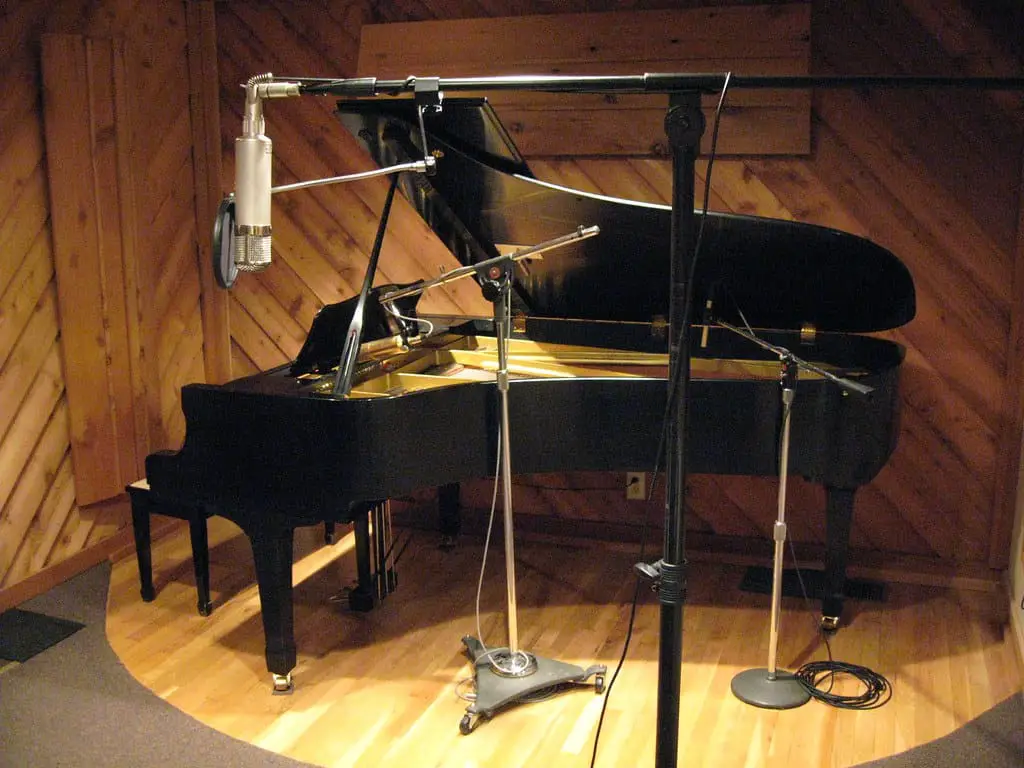With over 7,000 parts in a Grand Piano, no other acoustic instrument can compete with it. Sonically it truly is the master of instruments and capturing the frequencies when recording a Grand Piano is a detailed art form using different techniques. How to Mic a Grand Piano?
Inside
- AB Method-2 Small diaphragm tube condenser mics 11″ above strings, aiming down or
- 1 Mic aimed to treble strings-1 to bass strings
- X/Y Method-2 Omni Mics-just past Hammers-6″ to 9″ off strings-18″ to 27″ apart
Outside
- X/Y-Method-3’off Piano 5′ up.
- Blumlein Pair Method
- 1 Mic Method-3’off & 5′ up
The king of instruments when played hits a wide variety of frequencies that can become a complicated effort to capture but there are simple mic placement techniques that try.
Piano Recording Studio
#1 Technique-Mike Placement on the Inside of a Piano
Using Closed Miking-Spaced Pair (A-B) Miking & the Popular X/Y Mic Technique
- Positioning the mic inside the Piano can isolate the sound and cut the room out or other players from bleeding into the recording.
- Lower the lid for more isolation
- Position two tube condenser microphones approximately 11 inches above the strings,1-2 ft. apart pointing straight down. Condenser Cardioid Polar Pattern microphones are ideal for recording wide frequencies of the piano
- When using two mics it is important to always observe the 3:1 rule: Keep your mics at least three times farther from one another than each is from the piano strings (the sound source). Most sound engineers believe that the 3:1 rule for recording will minimize phase cancellation, technically this is not true. The 3:1 Rule works because of the level of the signal entering the second mic the one farther away is a reduced signal than the first mic is taking. Most all phase cancellation will happen when 2 signals are equal it’s just more noticeable at higher volume levels.
- Miking under the lid of the Piano will position mics closer to the Piano strings that will accentuate Brightness to the recording. You can EQ the high ends by moving the Capsules up and down farther or closer to the Strings to adjust it.
Most sound engineers will often say that there is no best way to mic a piano only the one that sounds the best for the Instrument- Room, and Player. The Piano has a wide array of tones and frequencies that placed in one environment is different than the next.
These Miking methods like Spaced Pair Mic Technique or AB Technique which are two condensers spaced a foot or two apart are placed at or around the unhinged side opening of a grand piano.
The two mics are spaced far enough so that a hard stereo panned left and right effect will be evident, but given their orientation, the phase issues should not be overwhelming.
They are the Standard starting points for most professional Sound Engineers and should be quite adequate for miking the kind of Grand Piano that’s been sitting in your house forever and a day.
If you are lucky enough to have a Grand Concert Piano sitting around your house and have been thinking of using it in some music recordings well good for you get it tuned!
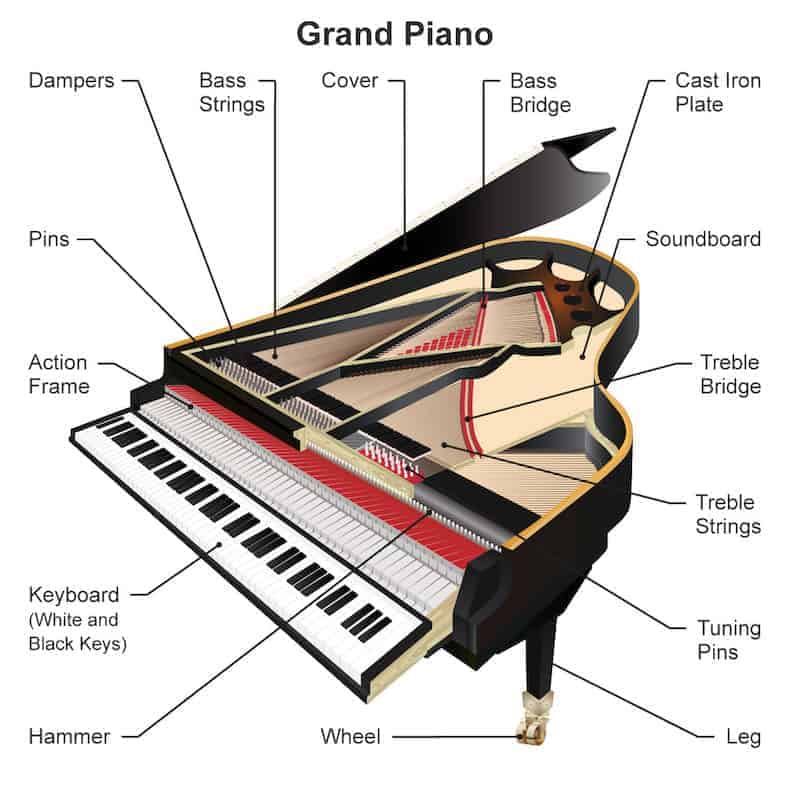
XY Mic Technique
Another Method for miking inside the Piano that is used the most in recording Grand Pianos is the Technique employs
- the X/Y Technique
- Using 2 Small diaphragm Omnidirectional Condenser Mics Placed directly over the strings in the Piano just past the Hammers. Place the microphones 6″ to 9″ above the strings and about 18″ to 27″ apart. There are even specialty piano microphones that sound amazing and greatly simplify this technique.
- A-B Technique or the Spaced Mic all involving 2 or more Mics
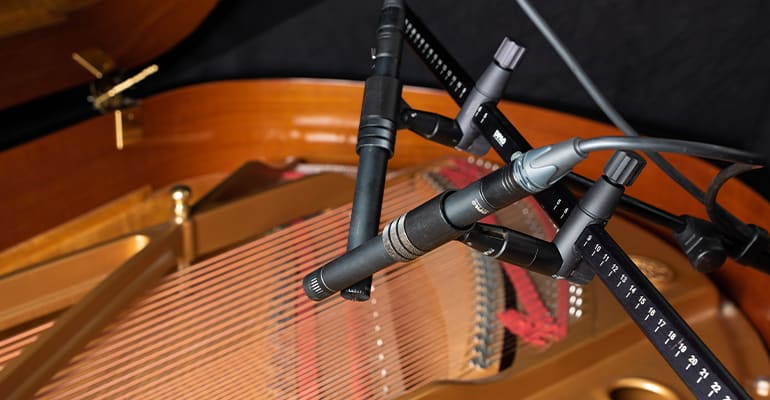
By recording in a mono mix, 1 mic over the treble string side, and 1 mic over the bass string side the sound from both mics can easily control the separated piano tones. A great mic that can be used in this application is Sennheiser Pro Audio Condenser Microphone (MKH 8050) available through Amazon.
Also with the mic placement close to the Piano’s Hammers, bright attack sound can be picked up which adds more brightness to the overall sound. That brightness captured here by the X/Y technique is used in Modern Day Worship music.
-
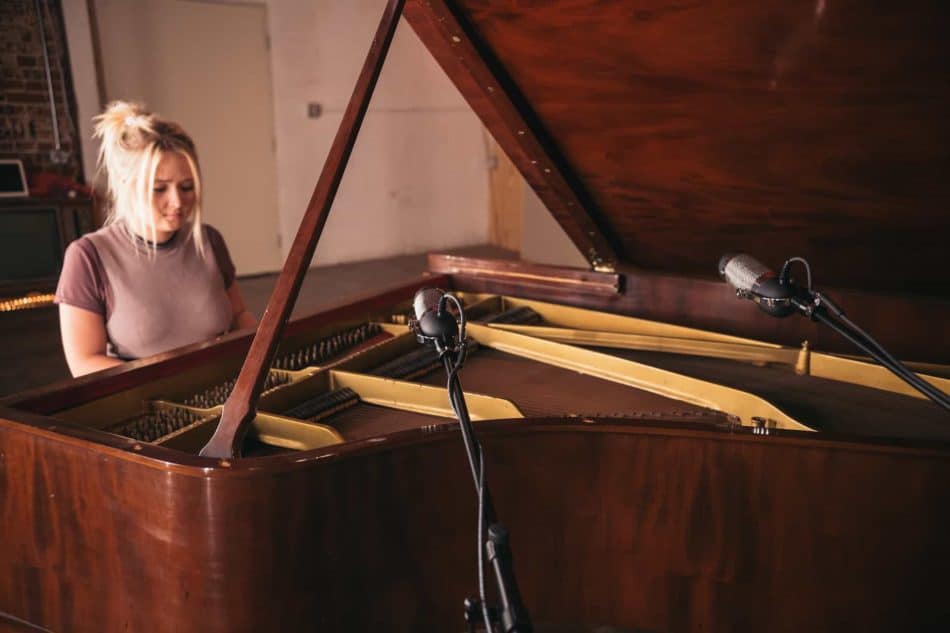
A-B Technique
- A variation of this 2 mic technique can add a 3rd mic called a boundary microphone affixed to the lid of the piano everything is the same except for the added mic. This allows you to close the piano’s lid for better isolation.
- Another variation for mic positions inside the Piano calls for a large-diaphragm cardioid microphone to be placed just inside of the lid. This spot is the apex of the rounded end of the piano’s body, so you will capture the piano’s richest and smoothest sound and little of its attack. This dramatic tone sits back in the mix and is wonderful on its own for accompanying vocals.
# 2 Technique- Miking Outside the Piano
- For a more natural sound using the ambiance of the room while recording
- Positioned the mics 2 Tube Condensers in an X/Y Configuration approximately 3 feet away and from the Piano and 5 feet up.
- Adjust the setting according to ear and taste but start here in this position for this technique.
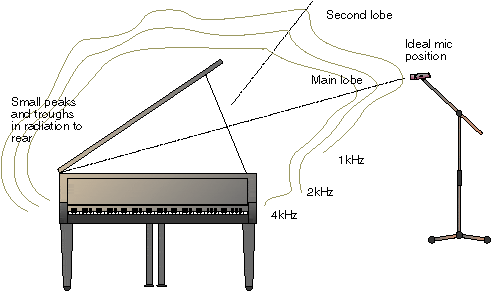
Use a Cardioid Condenser Microphone Outside that will handle the wide Frequencies that the Piano delivers Cardioid polar pattern reduces pickup of sounds from the sides and rear, improving the isolation of the desired sound source.
If you aren’t able to use multiple microphones, miking a piano at the sweet spot with a single microphone will suffice. In this case, try using different angling for the mic towards or away from the hammers in the piano that can pronounce them more or less.
Moving further away from the piano with a single microphone can also help capture a greater image of it. The room can add a lot to what the mic hears or doesn’t. Start at the Basics. Miking the piano doesn’t have to be complicated and can be accomplished with just 1 mic. Use the Room as an advantage if you can.
The room acoustics are such an important factor to consider when recording a concert grand piano. It is important to assess whether or not the room will do the instrument justice. No two rooms are the same.
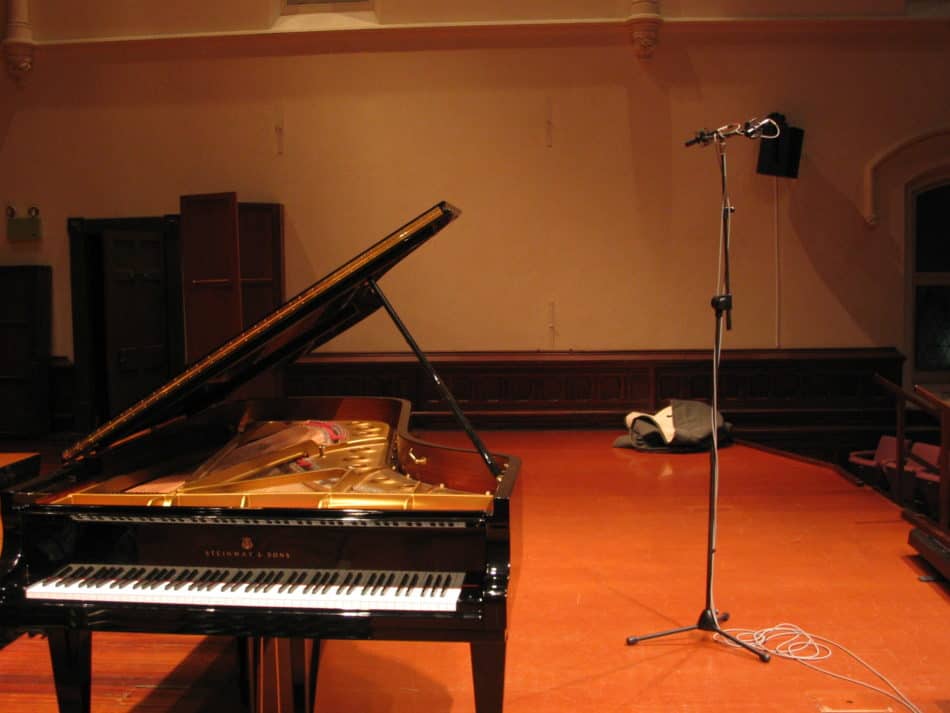
#3 Technique-Alternative Recording Techniques For a Grand Piano
A Concert Grand Piano is a formidable job when trying to record this massive instrument. At 7-9 feet long spanning from A0 with the earth-shaking frequency of 27.5Hz up to C8 with a fundamental frequency of 4186Hz.
The piano is a complicated acoustic instrument consisting of up to 7000 discrete parts. Hundreds of strings resonate sympathetically and then project in totally unpredictable directions. Challenges include reflections within the Piano lid, tuning, leakage from other instruments, and the fact that no two pianos sound exactly alike.
Grand or Baby Grand Piano is a very special instrument and the task to record one is a task for a whole different level. Just having a Piano and getting the Basic Microphone Placement and Position without the Intricate details should be all you’ll need to make a decent recording.
Concert Halls are built for Grand Piano where the reverberation times normally are acoustically tuned between 0.9 seconds to 1.3 seconds at 500 Hz and the room volume is a minimum of 10,000 cubic meters. Concert halls specially designed for playing music from the ever-famous composer Wagner can even have reverberation times of around two seconds.
The harmonics and overtones can reach beyond this and to capture the piano you’ll want to use mics with a well-balanced frequency response and an extended range if using anything other than a condenser design.
The Piano’s lid is used for dampening volume and timbre and to impart an important directionality to the projection of the instrument. This why the use of an Omnidirectional microphone works well recording the Grand Piano. The lid of the Piano uses the lid to create lots of off-axis reflections that the Omni can capture.
- Using a 2 Mic Spaced Pair or AB method inside the Piano a larger diaphragm mic can be used on the Bass side of the strings. Using the 3:1 Rule for a good guaranteeing good stereo correlation and good mono compatibility. This setup should create a nice stereo recording with a clear and well-defined movement between the left and right-hand passage
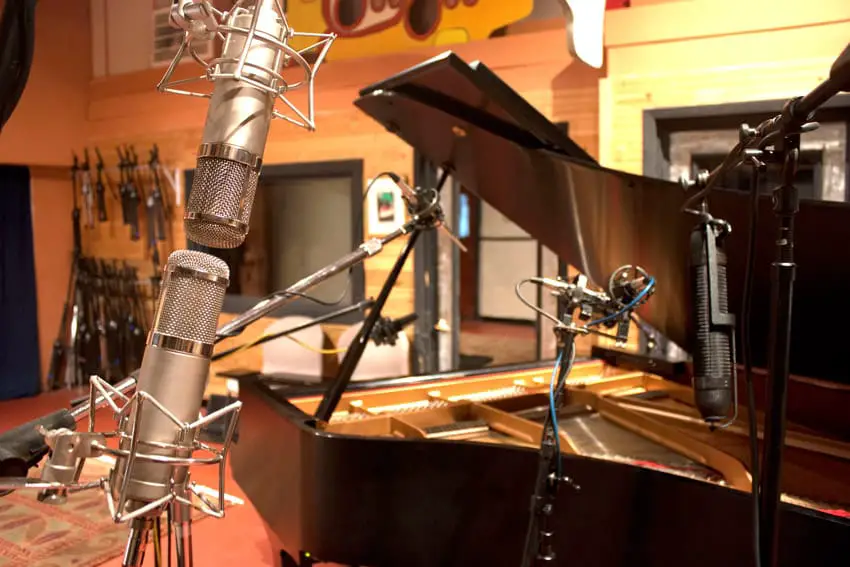
Blumlein Mic Technique
Another alternative method is to Record in Blumlein which requires 2 Bi-Directional Mics. Bi-directional means that it will pick up sounds from both sides of the microphones. The mic capsules are placed at 90 degrees to one another forming a Blumlein Pair. Just as in this photo. A great Mic set foe this Technique is available here through Amazon called a Cascade Microphones FAT HEAD BE Stereo Pair-Grey Body/Anodized Silver Grill
The top-end mic will be focused on the low end of the Piano and the bottom mic is focused on the high end of the Piano. This type of recording although it looks strange will reproduce a high-quality sound recording. The precision of a Blumlein recording more closely relates to what human ears hear than the other stereo techniques. For solo piano recording or general room miking, it captures a highly realistic image of the original sound.
The skinny on Miking Pianos is that if you use more than 1- 6 mics using Close Miking than a Small Diaphragm Condenser Mic will be accurate in that range and especially under the lid of the Grand Piano.
A large Diaphragm Condenser or Ribbon Microphone will work at farther range pointing from its sweet spot and taking the reflection of the lid and the ambiance of the room in along with the sound of the Piano. A great Mic for this Technique can be found here through Amazon called Audio-Technica AT4040 Cardioid Condenser Microphone a Ribbon Large Diaphram Condenser that will record beautiful tones and color that you would expect from a Grand Piano.
The Piano tends to sound the best when recorded in stereo where two signals are split traditionally with the bass on the left and treble on the right. which is how the pianist hears it.
There are complications that happen when trying to get a decent sound. that if you are using more than one mic shooting for a stereo image with X/Y Technique that works great and is a proven popular method for recording Piano inside under the lid and on the outside of the Piano. Overtop the giant instrument.
This is because there are multiple mics involved and because of the location of those mics when inside or even outside the huge instrument there are always going to be complications miking it.
For Home Recorders, You can get a fairly good sound with these Techniques not perfect (even for the big guys) but good enough for any kind of Piano.
So get those cobwebs off your Mom’s old Baby Grand, and tuner er up because now you know how to Mic er up. makes some tracks make some music!
JimGalloway Author/Editor
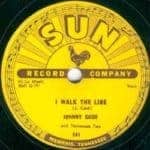
MikingDesign.com 11/15/19
References: MIKING THE GRAND PIANO


